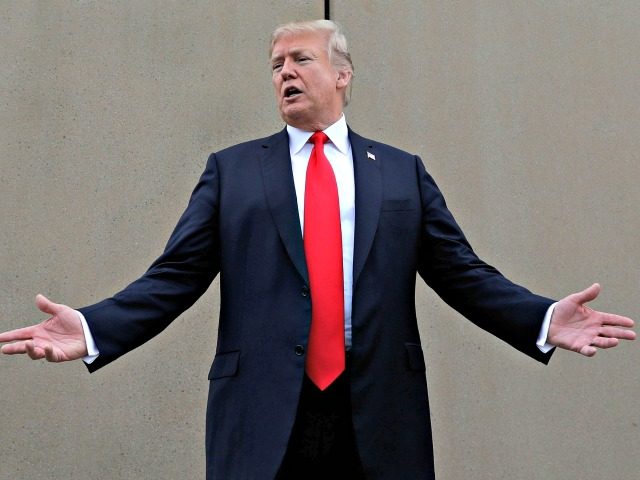President Donald Trump touted construction of the border wall on Tuesday, even though the draft budget for the Department of Homeland Security adds only enough funds to contract for just 55 miles of new wall in 2019.
The draft deal offers far less than the $5.7 billion and 234 miles requested by Trump.
Trump spoke before a cabinet meeting on Tuesday, and hinted he might redirect more funds for wall construction:
I can’t say I’m thrilled. But the wall is getting built, regardless. It doesn’t matter. Because we’re doing other things beyond what we’re talking about here. So we’ll see what happens.
In 2017 and 2018, Congress provided funds to build a total of 115 miles of new wall.
Trump told the reporters at the White House:
In fact, I noticed yesterday, when I got to [the February 11 rally in] El Paso, they had signs, “Finish the Wall,” instead of “Build the Wall.” Because we’re doing a lot of wall right now. Just started a big portion of the wall in the Rio Grande Valley, which is now the biggest area for people coming in. We’ve sealed up a lot of the areas where people come in.
The budget deal reportedly includes unusual language allowing officials to transfer $750 million from some projects to other projects. Trump hinted that officials plan to shift money from lower priority programs to wall construction. He said:
And we’re doing things that are fantastic and taking from far less — really, from far less important areas. And the bottom line is we’re building a lot of wall. Right now, we’re building a lot of wall.
…
The bottom line is — on the wall — we’re building the wall. And we’re using other methods, other than this and in addition to this. We have a lot of things going. We have a lot of money in this country, and we’re using some of that money — a small percentage of that money — to build the wall, which we desperately need.
Trump also hinted that he might also declare a national emergency to shift additional funds to wall construction:
[QUESTION] If Congress sends you a deal that you disagree with, would you consider declaring a national emergency to build the wall?
THE PRESIDENT: I consider everything. I’m considering everything. You know, we already have national emergencies out there. You know, President Obama, President Clinton, President Bush — they’ve declared many national — this is not unique. They’ve declared many national emergencies. Many, many. And you have some out there that we can use in addition to one that we can declare if we want to do it.
The border wall with Mexico is a mix of old metal panels and new bollard walls 30 feet high. Some of the wall sections include two walls with a road in between.
In January 2017, when Trump was inaugurated, the stretch of various walls added up to 654 miles along the border. A document from DHS says officials need a total of 762 miles of border wall:
Total Miles of Barrier Needed: ~762
316 miles of new primary border wall system
174 miles of primary border wall system in place of less effective designs
272 miles of secondary border wall
Money provided in 2017 and 2018 is funding new construction, says DHS, including:
Work On-going or Planned: More than 115 miles (FY 2017 and FY 2018 funding), including:
[Roughly] 83 miles of new primary wall in place of less effective existing barriers in San Diego, El Centro, Yuma, and El Paso Sectors
[Roughly] 14 miles of new secondary wall in place of less effective existing barriers in San Diego Sector
[Roughly] 13 miles of new levee wall system in the Rio Grande Valley Sector
[Roughly] ~8 to ~12 miles of new steel bollard wall system in the Rio Grande Valley Sector
The additional 55 miles of border wall will be built in the Rio Grande Valley, according to the draft budget deal.
Also, the administration has adopted a variety of new legal reforms which deny asylum to some migrants and shrink the catch-and-release rules which allow migrants to get jobs and pay their debts to the cartels.
These changes deny asylum to people who say they are threatened by criminals or violent spouses. The most important change — “Remain in Mexico” — requires some migrants to wait in Mexico for roughly two years until their claims for asylum can be heard in court.
These legal reforms can be more effective than a wall in blocking the movement of cheap workers into the U.S. labor market, largely because asylum laws allows migrants to legally walk into the United States.
Democrats and business groups oppose the reforms. For example, before the budget talks, Democrats said they want to reverse the asylum reforms, and so allow people who claim a fear of spouses or gangsters to get work permits and green cards for themselves and their families, no matter the width and height of a border wall.

COMMENTS
Please let us know if you're having issues with commenting.